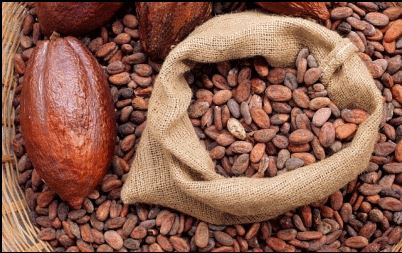
COCOA
The cocoa bean, fruit of the cocoa tree, acquired economic importance because it forms an essential element for the taste of chocolate, a worldwide popular delicacy. Cocoa beans come in three main varieties, namely Forastero, Criollo and Trinitario. Forastero is the most widely used variety of cocoa comprising around ninety percent of cocoa’s world production. Although the quality of Forastero is inferior to the other cocoa types, its beans are the biggest and much more resistant to diseases. The Criollo variety is considered as the highest quality cocoa bean but it has lower yields than those of Forastero, while also being less resistant to several diseases.
Most of the global cocoa production originates from the African continent. Throughout the cocoa bean history, most of these beans have been exported to Europe (in particular Germany and the Netherlands) and the USA for grinding processing. Recently, however, Africa is emerging as the top processor of cocoa beans.
The table below indicates production forecasts of the world’s top cocoa producers for the 2014-2015 season (the cocoa season runs from 1 October to 30 September the following year).

COCOA IN INDONESIA
INDONESIA’S COCOA PRODUCTION AND EXPORT
The cocoa bean is one of the most important agricultural export products of Indonesia. In the past 25 years, the Indonesian cocoa sector has experienced massive growth, driven by rapid expansion of smallholder farmer participation. Indonesian smallholders contribute – by far – most of the national production, thus outperforming big state plantations and large private estates. The country currently has approximately 1.5 million hectares of cocoa plantations.
Indonesia’s main locations of cocoa production are:
1. Sulawesi
2. North Sumatra
3. West Java
4. Papua
5. East Kalimantan

The main Indonesian cocoa producing region is the island of Sulawesi which accounts for around 75 percent of Indonesia’s total cocoa production. As Indonesia’s cocoa productivity per hectare has been lagging behind that of other cocoa-producing countries, the government started a five-year cocoa revitalization program in 2009 to boost production through intensification, rehabilitation and rejuvenation activities, covering a total area of 450 thousand hectares. Factors that are hampering progress in the cocoa industry are aging trees (planted in the 1980s), insufficient improved planting materials and little farm maintenance. More investment in this sector is needed to reach the government’s one million tonnes annual production target by 2013-2014.
In terms of export, cocoa forms Indonesia’s fourth largest foreign exchange earning from the agriculture sector (after palm oil, rubber and coconut). However, the majority of Indonesia’s cocoa export constitutes raw beans instead of processed cocoa, meaning that Indonesia loses out on added value revenues. The most important destination countries for Indonesia’s cocoa beans are Malaysia, the USA and Singapore.
The table below shows Indonesia’s national cocoa production and export.

FUTURE PROSPECTS OF THE INDONESIAN COCOA SECTOR
The World Cocoa Foundation stated that annual increase in global demand for cocoa has been three percent per year, for the past hundred years. It is estimated that global cocoa demand will increase by similar levels in the coming years and, as such, puts Indonesia in a potentially fortunate position as the country is one of the largest producers and exporters of this commodity. The country’s current primary competitive advantage lies in its ability to supply large quantities of cheap (lower quality) cocoa beans.
However, the country is facing difficulties in increasing cocoa’s important role in the economic development of Indonesia. Around 90 percent of Indonesia’s cocoa output is produced by smallholders who lack the financial means to optimize production capacity, resulting in declining productions due to aging trees, diseases, floods and such. Moreover, because of the recent promising perspectives of the palm oil and rubber industries, some Indonesian farmers have shifted their focus towards those commodities, causing that the current 1.5 million hectares of cocoa plantations may decline further in the coming years.
Throughout its history, the majority of Indonesia’s cocoa production has been exported in the form of raw cocoa beans. This has encouraged the government to stimulate national value-added processing industries. One important measure for this was the imposing of an export tax on raw cocoa beans in 2010 (decree No. 67/2010), amounting between five and 15 percent depending on world price fluctuations. Previously, export taxes only applied to processed beans. This new export tax is an incentive for establishing more domestic fermenting industries as well as a signal for processing firms to increase their performance as there have been reports that some cocoa bean processing firms are not operating at full capacity (this could be attributed to various factors, including the country’s inadequate infrastructure).
Recent reports state that Indonesia’s grinding capacity has expanded from 250,000 tons in 2009 to 480,000 tonnes in 2012, while cocoa exports are forecast to decline.
Source: https://www.indonesia-investments.com/business/commodities/cocoa/item241

